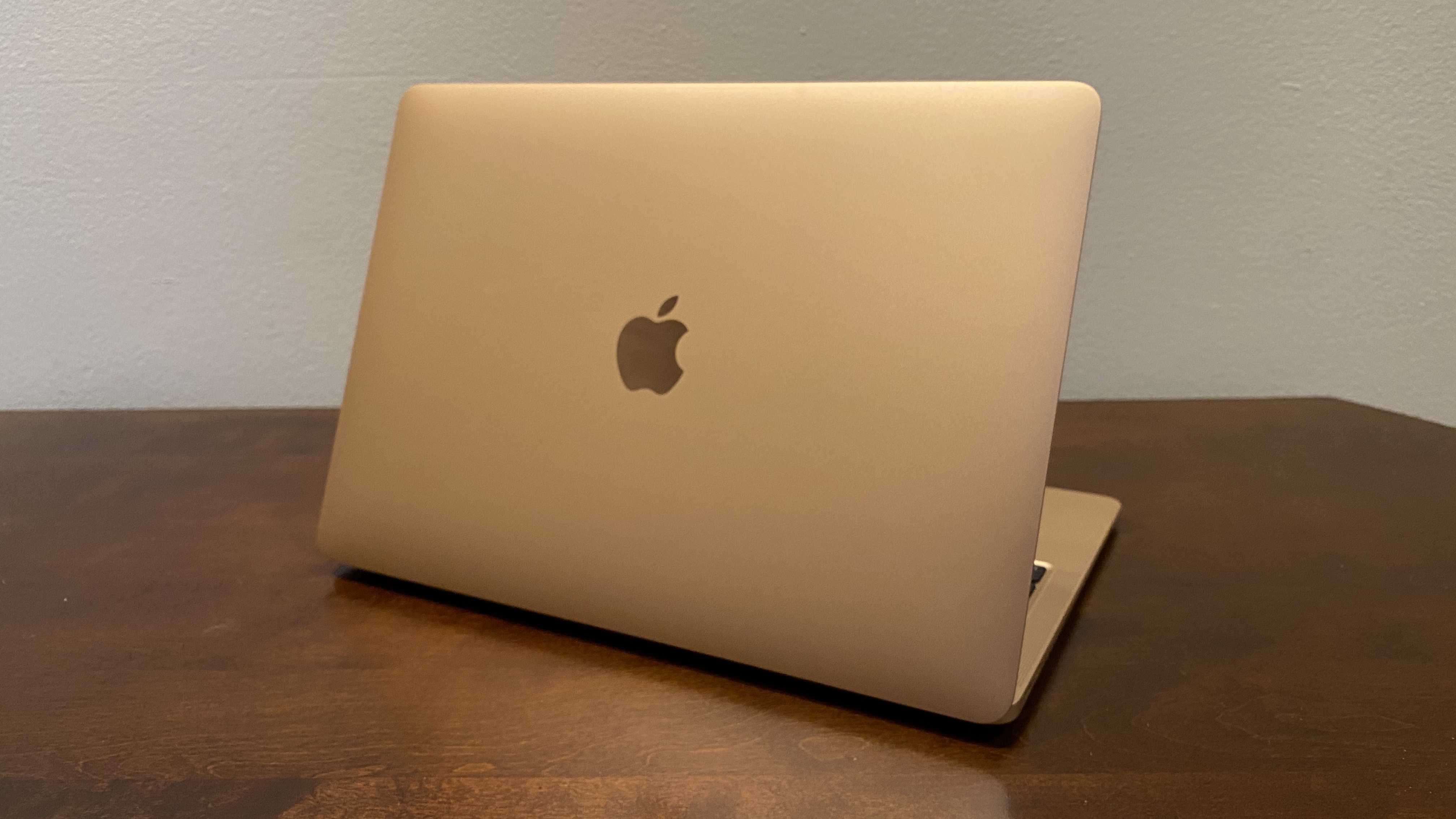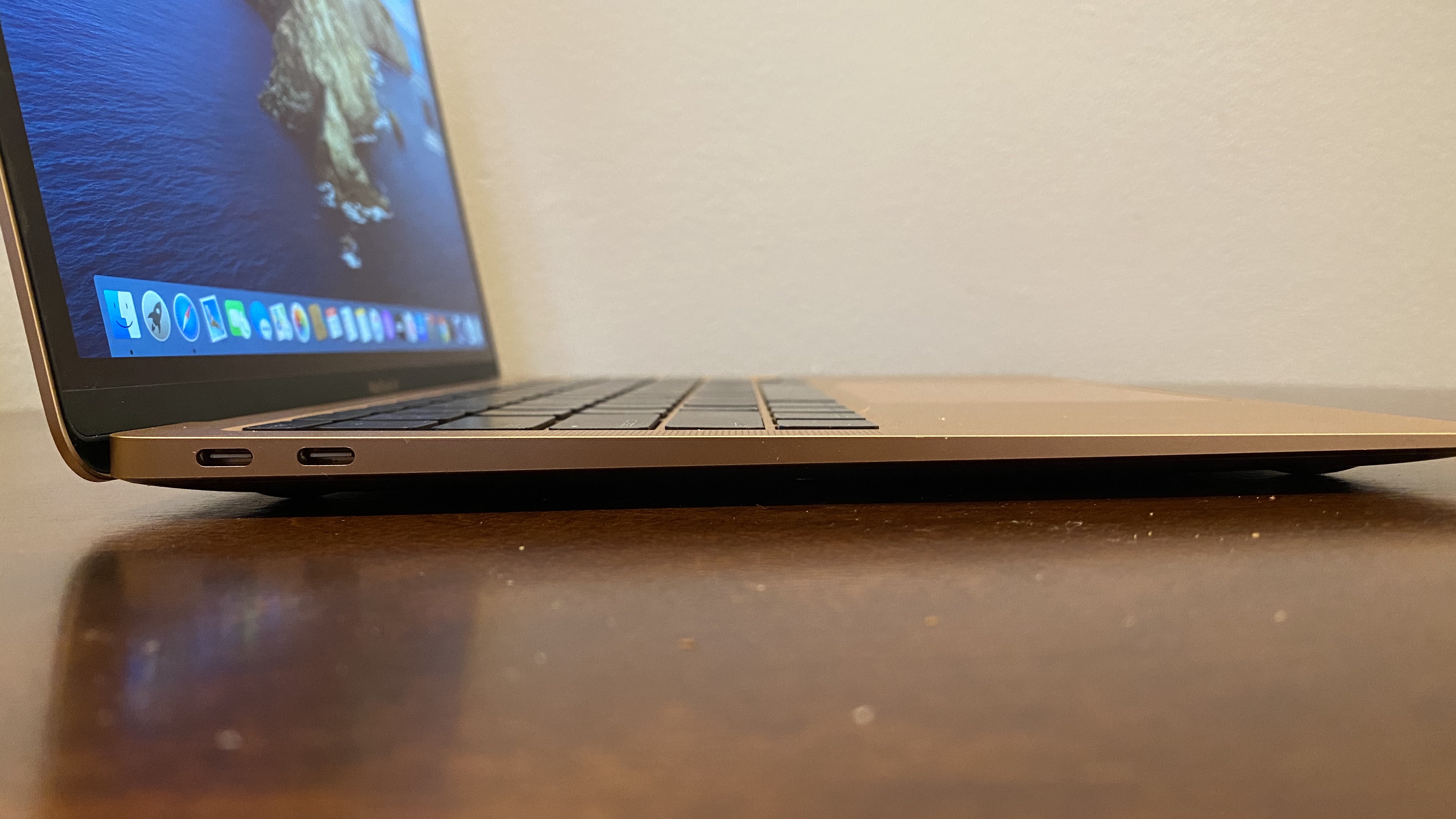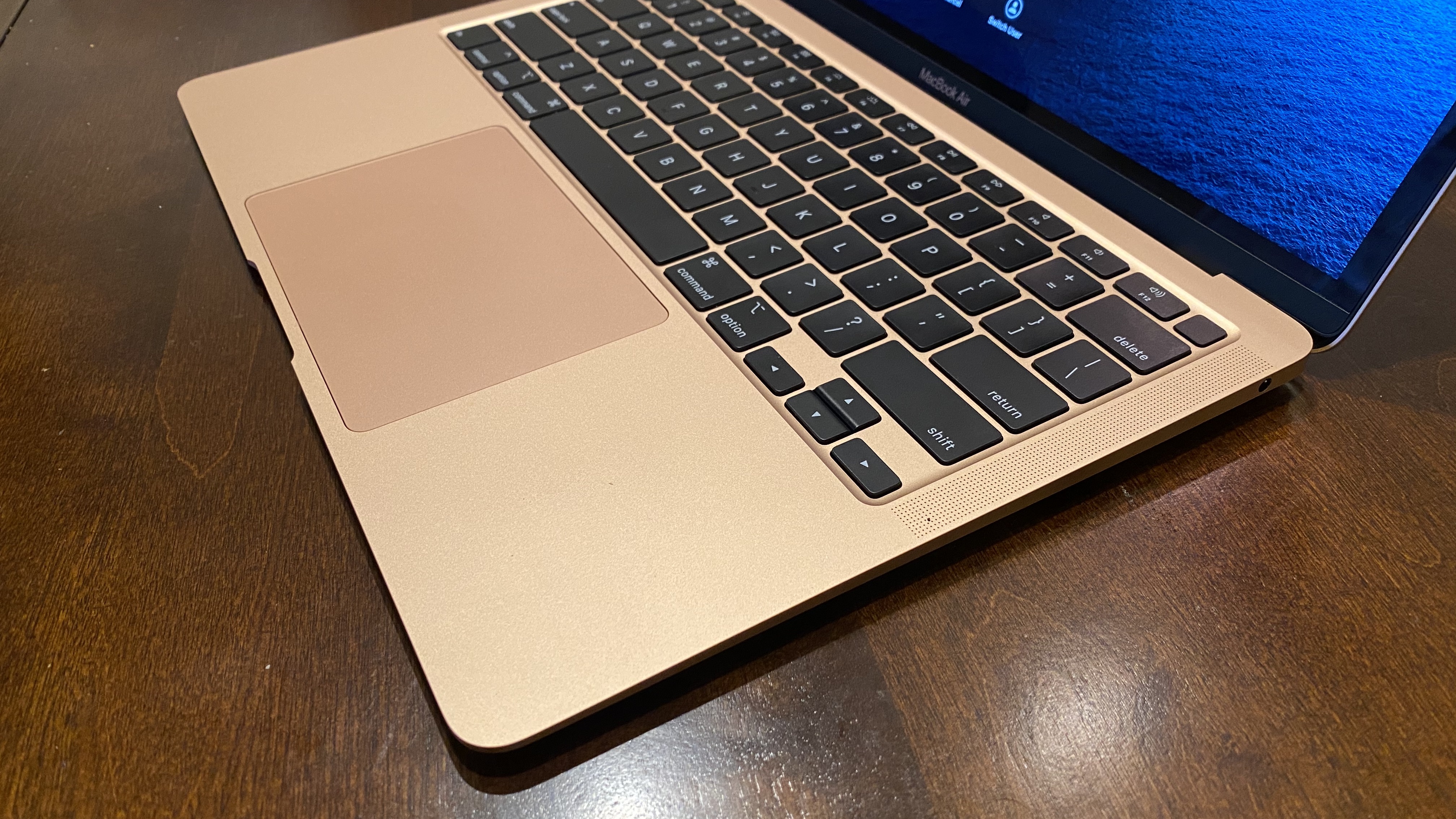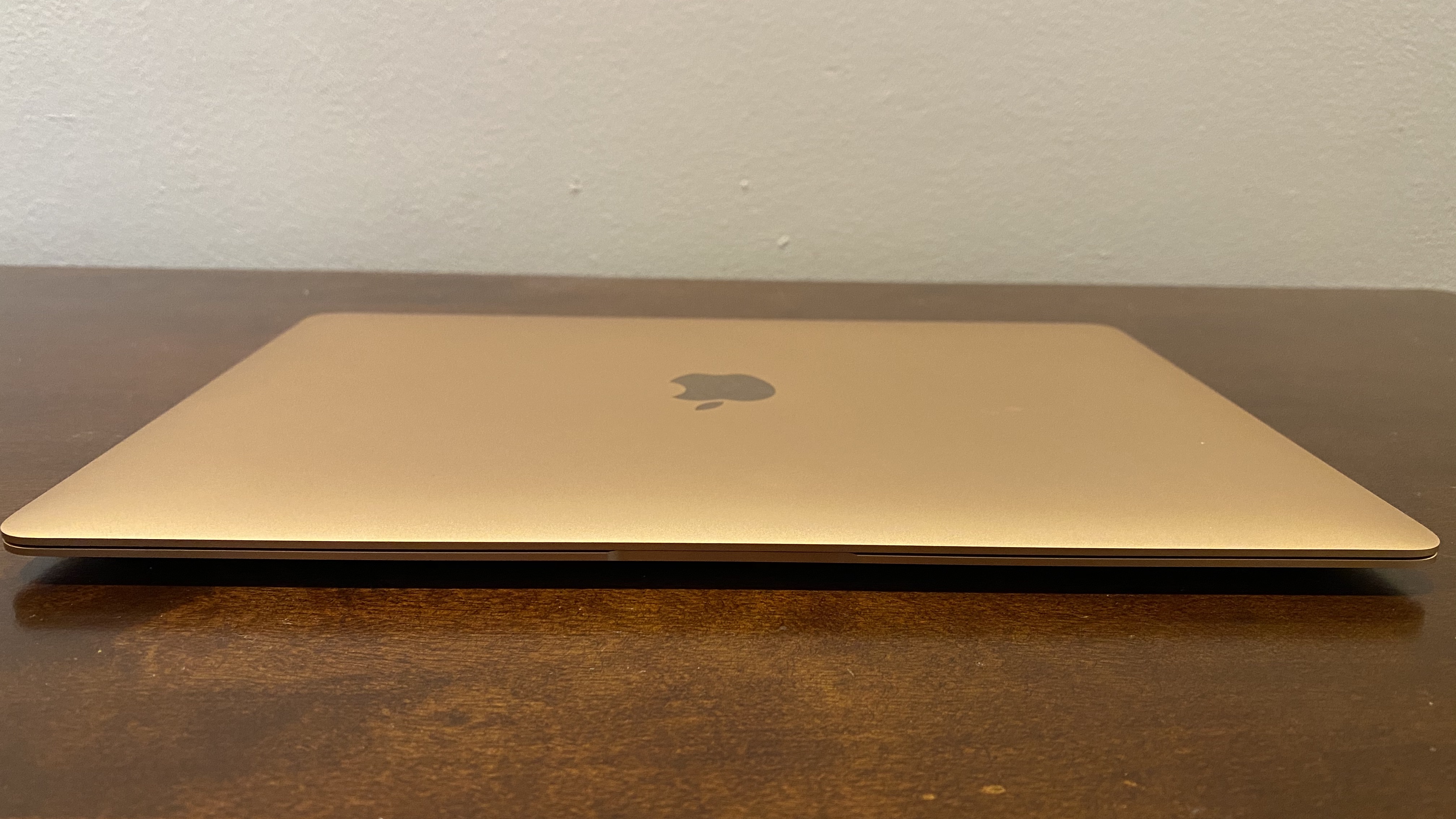Tom's Hardware Verdict
Apple’s MacBook is a return to form as a chic, premium laptop for everyday use with great speakers and an excellent set of speakers, though it falls behind Windows PCs in performance.
Pros
- +
Excellent keyboard
- +
Strong build quality
- +
16:10 display
- +
Chic design
- +
Detailed top-firing speakers
- +
Long battery life
Cons
- -
Limited ports
- -
Lackluster webcam
- -
Not as powerful as comparably priced Windows rivals
Why you can trust Tom's Hardware
The MacBook Air refresh you’ve been waiting for is here. Following last year’s 16-inch MacBook Pro, the 2020 MacBook Air ($999 to start, $1,299 as tested), finally has a keyboard we can recommend again, thanks to comfortable and clicky scissor switches. The new laptop also has all-day battery life and great speakers. But the MacBook Air’s new processors, Intel’s Y-series Ice Lake chips, aren’t as powerful as the ones you get in comparable Windows price for a similar -- or even lower -- price.
Design





The MacBook Air is as svelte and recognizable as ever. The 2020 update hasn’t brought changes in the aesthetic department. Our review unit is gold with a reflective Apple logo on the lid polished to a mirror sheen. (If you prefer something a bit more subtle, it’s also available in space gray or silver). A small notch in the front makes it easy to lift the lid with one finger.
Apple’s 13.3-inch, 16:10 display is a bit taller than some competing notebooks, which makes for a taller screen. That’s surrounded by a black bezel that’s thin, except for on the top. Most Windows-based laptops that have that thick a bezel on top fit an infrared camera for facial recognition, but the MacBook Air doesn’t.
The deck is the same gold color with a spacious touchpad, a pair of top-firing speakers and, the star of this year’s design, a redesigned keyboard with scissor switches and Touch ID.
Port selection is sparse, with a pair of Thunderbolt 3 ports on the left side and a headphone jack on the right side. The laptop starts at 0.6 inches thick, but tapers down to just under 0.2 inches, so there’s a sacrifice made for thinness. You can use either of the two Thunderbolt 3 ports for charging.
At 2.8 pounds and 12 x 8.4 x 0.6 inches, you can take the MacBook Air anywhere in a backpack and barely notice it’s there. It has some stiff competition in the Windows PC space there, though, in the Dell XPS 13 (2.8 pounds, 11.6 x 7.8 x 0.6 inches) and Acer Swift 5 (2.1 pounds, 12.5 x 8.3 x 0.6 inches).
Specifications
| CPU | Intel Core i5-1030NG7 |
|---|---|
| Graphics | Intel Iris Plus |
| Memory | 8GB LPDDR4-3733 |
| SSD | 512 GB PCIe NVMe SSD |
| Display | 13.3-inch, 2560 x 1600, 16:10, True Tone Display |
| Networking | 802.11ac Wi-Fi, Bluetooth 5.0 |
| Ports | 2x Thunderbolt 3; 1x Headphone jack |
| Camera | 720p Facetime camera |
| Battery | 49.9 Wh |
| Power Adapter | 30W |
| Operating System | macOS Catalina (10.15) |
| Dimensions (WxDxH) | 12 x 8.4 x 0.6 inches / 304.8 x 213.4 x 15.2mm |
| Weight | 2.8 pounds / 1.3 kg |
| Price (as configured) | $1,299 |
Productivity Performance
We reviewed this year’s MacBook Air with an Intel Core i5-1030NG7, a 10W Ice Lake processor with four cores and eight threads. The CPU has a base frequency of 1.1 GHz with boost up to 3.5 GHz. That CPU was paired with 8GB of RAM and a 512GB PCIe-based SSD. What this means for those who don’t focus on the specs is that it can handle most types of everyday computing, but don’t expect to do any serious video editing on this.



On Geekbench 5.0, the MacBook Air notched a score of 2,738. That fell behind the cheaper Acer Swift 5 (3,637, Intel Core i7-1065G7, 8GB) and, unsurprisingly, the Dell XPS 13 (4,848, Intel Core i7-1065G7), which we tested with 16GB of RAM.
When it came to file transfer, it took the MacBook Air 10 seconds to copy 4.97GB of files, a rate of 508.9 MBps. That’s the same as the Acer Swift 5, though slightly slower than the Dell XPS 13 (621 MBps). In practice, your experience may be different. Apple’s APFS file system has proven to be extremely fast, as it can clone files with just small amounts of data from the original. Our file transfer test uses the command line in Terminal.
Get Tom's Hardware's best news and in-depth reviews, straight to your inbox.
We also ran our Handbrake test, which transcodes a 4K resolution video to 1080p. It took the MacBook Air 27 minutes and 10 seconds, which put it behind its i7-clad competitors.
To stress test the MacBook Air, we ran Cinebench R20 on a loop for 20 runs. Unlike many laptops we tested, there wasn’t a significant drop after its initial score of 986. It’s lowest score was 953, but most runs were in the 960s. The average CPU speed was 1.6 GHz, and the average CPU temperature measured 99.4 degrees Celsius (210.9 degrees Fahrenheit), which is just shy of the maximum temperature for this CPU of 100 degrees Celsius. You could really hear the fans running during this test.
Keyboard and Touchpad
Beyond the new processors, the big update to the MacBook Air is the addition of what Apple calls its Magic keyboard, which uses scissor switches with 1mm of travel. These are a huge improvement over the butterfly switches found in recent models, and are a return to form. To many, this will be what makes the MacBook Air easy to recommend again.
On the 10fastfingers.com typing test, the MacBook Air’s keyboard was a joy to use. It’s comfortable, and I reached 103 words per minute with my standard 2% error rate. I personally didn’t mind the butterfly switches so much (durability concerns aside), but these are heads and shoulders better.
A Touch ID fingerprint reader is built into the power button on the keyboard and worked flawlessly to log me into my account.
The 4.8 x 3.2-inch Force Touch trackpad is spacious and responsive to gestures, including switching between desktops and showing all open windows.
Display
Apple’s 13.3-inch Retina display has a resolution of 2560 x 1600 and a 16:10 aspect ratio. It uses Apple’s True Tone technology to adjust the display to be accurate based on ambient lighting conditions, though anyone doing creative work may want to turn that off. When I watched an FHD trailer for Black Widow, the orange and blue popped on Taskmaster’s white hood, and I found the screen to be plenty bright.
The MacBook Air’s display covers 80% of the DCI-P3 color gamut, falling behind the Swift 5 (84.9%) and just a smidge under the XPS 13 (81.3%).
It measured an average of 113 nits of brightness, about on par with the XPS 13 (115 nits) and slightly under the Acer Swift 5 (120 nits).
Upgradeability
There are 10 screws on the bottom of the MacBook Air, but getting inside won’t let you upgrade. The RAM and SSD are both soldered to the motherboard, so it’s extremely important to pick a configuration that will fit all of your needs when you make your purchase.
Battery Life
Apple’s latest can last all day on a charge with ease. Our battery test continuously browses the web, streams video and runs OpenGL tests in the browser all at 150 nits of brightness. The MacBook Air endured for 9 hours and 31 minutes, surpassing the Acer Swift 5, though the Dell XPS 13 (12:39) with its 1920 x 1200 screen option lasted longer. Dell’s 4K version lasted 8:14.
Heat
When we ran our Cinebench R20 stress test, we also took skin temperature measurements.
The center of the keyboard, between the G and H keys, reached 37.3 degrees Celsius (99.1 degrees Fahrenheit), while the touchpad was cool at 30.3 degrees Celsius (86.5 degrees Fahrenheit).
The hottest spot on the bottom of the laptop measured 41.4 degrees Celsius (106.5 degrees Fahrenheit).
Audio
The MacBook Air may not have the powerful speakers of the 16-inch MacBook Pro, but it’s still excellent for a laptop this thin. When I played The Weeknd’s “Heartless,” the song immediately filled my small New York City apartment with drums, vocals and synths. They were evenly balanced, and I could even make out the bass, which is often sacrificed in other thin notebooks. Apple really knows its notebook speakers.
Webcam
The 720p camera on the MacBook Air is, at best, usable. Colors are accurate enough, but the picture is grainy. It’s ironic that a computer that looks so good itself can make its user look subpar. I’d use this to call my family but would think twice about using it for professional calls.
Software and Warranty
The MacBook Air comes preinstalled with the latest version macOS, Catalina (10.15). The latest update to macOS separates iTunes into separate apps: Music, TV and Podcasts. It also supports dark mode. But the big issue for power users may be a lack of support for 32-bit apps.
Unlike many Windows laptops, macOS doesn’t come with any bloatware. You get a suite of productivity apps, as well as maps and multimedia, support for iMessage and FaceTime. You can, of course, install software from the App Store or the web.
If you need to return to a clean version of macOS, here's how to reset a MacBook.
Apple sells the MacBook Air with 90 days of tech support and a 1-year warranty.
Configurations
Our review unit is $1,299.99 with an Intel Core i5-1030NG7, 8GB of LPDDR4-3733 RAM and 512GB of PCIe storage.
The base model is $999 with an Intel Core i3 processor and a 256GB SSD.
The MacBook Air can go up to $2,249 with an Intel Core i7, 16GB of RAM and 2TB of SSD storage.
Bottom Line
It’s easy to recommend the MacBook Air again.
Apple’s latest is slim, chic and, yes, it has an excellent keyboard. Not only that, but it has great speakers and lasts all day on a charge.
Its biggest issue is that, yes, its performance trails those of comparable Windows laptops, including some cheaper ones, by quite a bit. This system isn’t a value by any means. If you get it, it’s for build quality and, of course, macOS. If you’re looking for power in a slim form factor, the Dell XPS 13 also brings style, while the Acer Swift 5 is both thin and more affordable.
But for casual users who want a thin laptop that’s built solid and who also love macOS and the Apple ecosystem, there’s a new no-brainer.

Andrew E. Freedman is a senior editor at Tom's Hardware focusing on laptops, desktops and gaming. He also keeps up with the latest news. A lover of all things gaming and tech, his previous work has shown up in Tom's Guide, Laptop Mag, Kotaku, PCMag and Complex, among others. Follow him on Threads @FreedmanAE and BlueSky @andrewfreedman.net. You can send him tips on Signal: andrewfreedman.01
-
bit_user I realize the site's logo involves a hammer, but I felt a brief moment of unease at seeing a hammer positioned next to a laptop...Reply -
SirCrono After seeing a review showing a slower laptop with a shorter battery life and higher price tags than its competitors, the hammer seems to be the only reasonable option :pReply -
Unolocogringo As always with Apple,less for more $.Reply
You are paying for the logo not the hardware.
Just like all apple phone covers have a big hole in the back so everyone can see the logo. Less material than other covers but it cost lots more.
And yeah my first impulse was to use the hammer on it also.:evil: -
daedalus1 Sorry couldn't be bothered to read the review. I could not get past the typos and grammar mistakes in the title and introduction. Does no one proof read any more?Reply -
kjfatl Reply
The extra cost is justified based on the Apple user experience compared to the Google(Chromebook) or Microsoft(Windows) user experience.Unolocogringo said:As always with Apple,less for more $.
You are paying for the logo not the hardware.
Just like all apple phone covers have a big hole in the back so everyone can see the logo. Less material than other covers but it cost lots more.
And yeah my first impulse was to use the hammer on it also.:evil:
If cost is the issue, the only real choice is Chromebook which is 1/2 of the cost of the Microsoft solution, and far easier to support from an IT perspective.
If you want a great user experience where almost everything works and will continue to work, go with Apple.
It's getting harder and harder to justify going with the Windows solution.
The big thing missing from the review is a comparison between the MacbookAir 2020 and 2019 models. -
Unolocogringo Reply
I would never buy a Chromebook, Microsoft Surface or Apple product.kjfatl said:The extra cost is justified based on the Apple user experience compared to the Google(Chromebook) or Microsoft(Windows) user experience.
If cost is the issue, the only real choice is Chromebook which is 1/2 of the cost of the Microsoft solution, and far easier to support from an IT perspective.
If you want a great user experience where almost everything works and will continue to work, go with Apple.
It's getting harder and harder to justify going with the Windows solution.
The big thing missing from the review is a comparison between the MacbookAir 2020 and 2019 models.
They are all a waste of money in my opinion.
So saying Apple is the better of the three is not saying much and still puts it near the bottom of the list.
At least with windows pro I can delay updates until I know they will not crash my computers, unlike Apple or Chrome.
I can also disable almost all of the tracking,data mining,email collecting, contacts collecting etc..... and still have a functioning computer.
Not so with Apple or chrome.
So saying overpaying for the Apple user experience is a good thing is your opinion. Not FACT. -
kjfatl It's not either one or the other.Reply
For my daughter, the MacBook Air is currently the best choice.
Personally I prefer working on a Linux server farm with 1000+ or more CPUs behind a serious firewall; but this is for work. I run applications that run out of RAM when less than 128GB is partitioned. For my customers, I have a custom motherboard running a proprietary version of Linux. For my personal use, I haven't decided what to get next- High end Windows desktop, cheaper laptop, or high end laptop. -
bit_user Reply
I worked with a Mac head (a convert, actually) who said the price premium was just a way of paying for the software.Unolocogringo said:As always with Apple,less for more $.
You are paying for the logo not the hardware.
Me: "okay, the PC laptop I just bought was $1500 and the equivalent Powerbook is $3k. If MacOS is worth $1500 to you, then have at it!" -
bit_user Reply
Honestly, remote work for my employer is the only reason I still run any Windows PCs. Otherwise, I'd just be 100% Linux.kjfatl said:For my personal use, I haven't decided what to get next- High end Windows desktop, cheaper laptop, or high end laptop.







